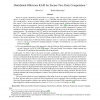Free Online Productivity Tools
i2Speak
i2Symbol
i2OCR
iTex2Img
iWeb2Print
iWeb2Shot
i2Type
iPdf2Split
iPdf2Merge
i2Bopomofo
i2Arabic
i2Style
i2Image
i2PDF
iLatex2Rtf
Sci2ools
IACR
2011
2011
Multi-Server Oblivious RAM
Secure two-party computation protocol allows two players, Alice with secret input x and Bob with secret input y, to jointly execute an arbitrary program π(x, y) such that only the output of the program is revealed to one or both players. In the two player setting, under computational assumptions most approaches require to first “unroll” π into a circuit, and then execute this circuit in a private manner. Without unrolling the circuit, an alternative method was proposed by Ostrovsky and Shoup (in STOC 1997) [28] with both players simulating the CPU of an oblivious RAM machine using “off-the-shelf” secure two-party computation to perform CPU simulation with atomic instructions implemented by circuits and relying on one of the players to implement encrypted memory. The simulation of the CPU must be done through circuit-based secure two-party computation, thus CPU “memory” in the Oblivious RAM simulation must be minimized, as otherwise it impacts simulation of each step of ...
| Added | 23 Dec 2011 |
| Updated | 23 Dec 2011 |
| Type | Journal |
| Year | 2011 |
| Where | IACR |
| Authors | Steve Lu, Rafail Ostrovsky |
Comments (0)

